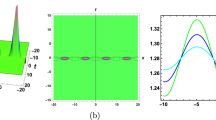Abstract
The role of dispersions in the numerical solutions of hydrodynamic equation systems has been realized for long time. It is only during the last two decades that extensive studies on the dispersion-controlled dissipative (DCD) schemes were reported. The studies have demonstrated that this kind of the schemes is distinct from conventional dissipation-based schemes in which the dispersion term of the modified equation is not considered in scheme construction to avoid nonphysical oscillation occurring in shock wave simulations. The principle of the dispersion controlled aims at removing nonphysical oscillations by making use of dispersion characteristics instead of adding artificial viscosity to dissipate the oscillation as the conventional schemes do. Research progresses on the dispersion-controlled principles are reviewed in this paper, including the exploration of the role of dispersions in numerical simulations, the development of the dispersion-controlled principles, efforts devoted to high-order dispersion-controlled dissipative schemes, the extension to both the finite volume and the finite element methods, scheme verification and solution validation, and comments on several aspects of the schemes from author's viewpoint.
Similar content being viewed by others
References
Thom A, Apelt CJ. Field Computations in Engineering and Physics. C Ven Nostrand Company, Ltd, 1961
Von Neumann. Proposal and analysis of a numerical method for the treatment of hydrodynamic shock problem. Nat Def and Res Com Report AM-551, March 1944
Hirt CW. Heuristic stability theory for finite-difference equations.J Comp Phys, 1968, 2: 339–355
Warming RF, Hyett BJ. The modified equation approach to the stability and accuracy analysis of finite-difference methods.J Comp Phys, 1974, 14: 159–179
Harten A, Osher S. Uniformly high-order accurate non-oscillatory schemes I.SIAM J Numerical Analysis, 1987, 24: 279–309
Fromm JE. A method for reducing dispersion in convective difference schemes.J Comp Phys, 1968, 3: 176–189
Rusanov VV. On difference schemes of third order accuracy for nonlinear hyperbolic system.J Comp Phys, 1970, 5: 507–516
Warming RF, Beam RM. Upwind second-order difference schemes and applications in unsteady aerodynamic flows. In: Proc AIAA 2nd Computational Fluid Dynamics Conference, Hartford, Connecticut, 1975. 17–28
Zhang HX. Non-oscillatory and non-free-parameter dissipation difference scheme.Acta Aerodynamica Sinica, 1998, 6: 143–165
Jiang Z. Study on the Finite Difference Theory and Numerical Methods of Weak Solution Problems. [PhD Dissertation], Peking University, Beijing, China, March 1993
Jiang Z, Takayama K, Chen YS. Dispersion conditions for non-oscillatory shock capturing schemes and its applications.Computational Fluid Dynamics J, 1995, 2: 137–150
Fu DX, Ma YW, Kobayashi T et al. Nonphysical oscillations in numerical solutions-reason and improvement.Computational Fluid Dynamics J, 1996, 4: 427–450
He GH, Zhang HX. Application of a new third-order ENN scheme to the Euler/Navier-Stokes equations. In: Proc of the First Asian CFD Conference, Hong Kong, 1995-01-16-18, 1995. 705–710
Li Q, Li ZW, He GH. The high accuracy difference methods for solving gas dynamics equations. In: Proc of the Second Asian Workshop on Computational Fluid Dynamics, Tokyo, Japan, 1996-12-19-23, 1996. 227–231
Zhuang FG, Zhang HX, Zhang LP, et al. High order schemes, hybrid grids and numerical simulation of the flow field. In: Proc of 7th International Symposium of Computational Fluid Dynamics, Beijing, China, 1997-09-4-8, 1997. 68–83
Zhang LP, Zhang HX. Development of NND scheme on unstructured grids.Acta Mechanica Sinica, 1996, 28: 135–142 (in Chinese)
Wu WY, Cai QD. A new NND finite element scheme on unstructured grids.Acta Aerodynamica Sinica, 1998, 16: 1–13
Takayama K, Jiang Z. Shock wave reflection over wedges: a benchmark test for CFD and experiments.Shock Waves, 1997, 7: 191–203
Jiang Z, Takayama K. An investigation into the validation of numerical solutions of complex flowfields.J Comp Phys, 1999, 151: 479
Zhuang FG. On numerical techniques in CFD.Acta Mechanica Sinica, 2000, 16: 193–216
Huang H, Zeng M, Qu ZH. Numerical study of thermochemical non-equilibrium radiation flowfield.Acta Mechanica Sinica, 2000, 32: 541–546 (in Chinese)
Ye ZY, Wei FS, Li JQ, et al.. Application of NND scheme on magneto-hydrodynamics equations.Acta Mechanica Sinica, 2001, 33: 301–308 (in Chinese)
Li ZH, Zhang HX. Study on gas kinetic algorithm for flows from rarefield transition to continuum using Boltzmann model equation.Acta Mechanica Sinica, 2002, 34: 145–155 (in Chinese)
Jiang Z, Matsuoka K, Sasoh A, et al. Numerical and experimental investigation of wave dynamic processes in high-speed train/tunnels.Acta Mechanica Sinica, 2002, 18: 209–226
Jiang Z. Reliable CFD validation based on optical flow visualization.Acta Mechanica Sinica, 2003, 19(3): 193–203
Steger JF, Warming RF. Flux vector splitting of the inviscid gasdynamic equations with applications to finite difference methods.J Comp Phys, 1981, 40: 263
Zhang HX, Zhuang FG. NND Schemes and their applications to numerical simulation of two and three-dimensional flows.Advances Appl Mech, 1991, 29: 193–256
Author information
Authors and Affiliations
Additional information
The project supported by the National Natural Science Foundation of China (90205027)
Rights and permissions
About this article
Cite this article
Zonglin, J. On dispersion-controlled principles for non-oscillatory shock-capturing schemes. Acta Mech Sinica 20, 1–15 (2004). https://doi.org/10.1007/BF02493566
Received:
Revised:
Issue Date:
DOI: https://doi.org/10.1007/BF02493566




